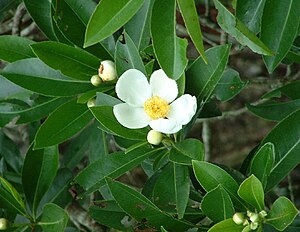Gordonia (genus of plants)
| Gordonia | ||||||||||||
|---|---|---|---|---|---|---|---|---|---|---|---|---|

|
||||||||||||
| Systematics | ||||||||||||
|
||||||||||||
| Scientific name | ||||||||||||
| Gordonia | ||||||||||||
| J. Ellis |
Gordonia is a genus in the tea shrub family(Theaceae), whichis related,among other things, to the camellias ( Camellia ). Some species are valued ornamental plants in warm climates.
description
Gordonia are evergreen deciduous trees . Their glossy, dark green, distich or spirally arranged leaves are leathery and entire or toothed. At the tip of the flower stalk there are two to seven decaying bracts .
The five sepals are unevenly shaped and do not fall off when ripe, the five (rarely up to ten) petals are weakly fused together at the base. The stamens have grown at the base of the corolla and form fleshy thickenings there, the anthers are mobile. The ovaries are five-fold (3 to 10), each carpel they carry three to five (two to ten) ovules . The short to long stylus is usually simple, rarely more or less branched, the scar is little head-shaped.
The fruit is a cylindrical capsule with a central column (columella), often angular lengthways. The seeds are flat and winged, the embryo is curved, the cotyledons are flat and thin, as is the endosperm .
distribution
Gordonia species are now only found in the New World such as B. Gordonia lasianthus from southwest North America. The Asiatic species that were previously classified here belong to another tribe of the Theaceae family and are now almost all of the genus Polyspora .
Systematics
The genus was first described by John Ellis in 1771 . Depending on the author, 20 to 65 species are recognized. Well-known types are:
- Gordonia lasianthus (L.) J. Ellis : It is found in Alabama, Florida, Georgia, Mississippi, North Carolina and South Carolina.
Is no longer put to Gordonia today:
- Gordonia axillaris (Roxb. Ex Ker Gawl.) Endl. = Polyspora axillaris (Roxb. Ex Ker Gawl.) Sweet ex G. Don
proof
- PF Stevens et al .: Theaceae. In: Klaus Kubitzki (Ed.): The Families and Genera of Vascular Plants - Volume VI - Flowering Plants - Dicotyledons - Celastrales, Oxalidales, Rosales, Cornales, Ericales , 2004, pp. 468–469, ISBN 978-3-540- 06512-8
Individual evidence
Most of the information in this article has been taken from the sources given under references; the following sources are also cited:
- ↑ a b Gordon Cheers (Ed.): Botanica , p. 410, 2003, ISBN 3-8331-1600-5
- ↑ SX Yang, JB Yang, LG Lei, DZ Li, H. Yoshino & T. Ikeda: Reassessing the relationships between Gordonia and Polyspora (Theaceae) based on the combined analyzes of molecular data from the nuclear, plastid, and mitochondrial genomes , in Plant Systematics and Evolution , Volume 248, 2004, pp. 45-55.
- ↑ Information from IPNI, Online , accessed on July 27, 2008
- ^ Gordonia in the Germplasm Resources Information Network (GRIN), USDA , ARS , National Genetic Resources Program. National Germplasm Resources Laboratory, Beltsville, Maryland. Retrieved October 5, 2017.